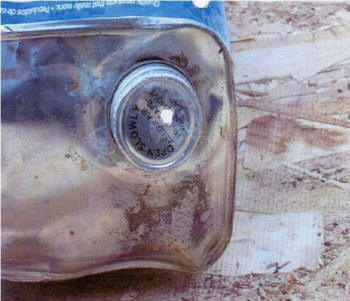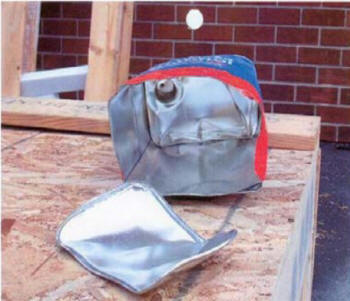|
<<< Back to Safety and Health Information Bulletins - Table of Contents by Year |
 Printing Instructions
Printing Instructions |
| |
|
 |
U. S. Department of Labor
Occupational Safety and Health Administration
Directorate of Science, Technology and Medicine
Office of Science and Technology Assessment |
Hazards of Using Flammable Liquids in Cutting Laminated Glass
|
|
Safety and Health Information Bulletin |
|
|
SHIB 10-06-2008 |
|
|
This Safety and Health Information Bulletin is not a standard or regulation, and it creates no new legal obligations. The Bulletin is advisory in nature,
informational in content, and is intended to assist employers in providing a safe and healthful workplace. Pursuant to the Occupational Safety and Health Act,
employers must comply with hazard-specific safety and health standards promulgated by OSHA or by a state with an OSHA-approved state plan. In addition,
pursuant to Section 5(a)(1), the General Duty Clause of the Act, employers must provide their employees with a workplace free from recognized hazards likely to
cause death or serious physical harm. Employers can be cited for violating the General Duty Clause if there is a recognized hazard and they do not take
reasonable steps to prevent or abate the hazard. However, failure to implement any recommendations in this Safety and Health Information Bulletin is not, in
itself, a violation of the General Duty Clause. Citations can only be based on standards, regulations, and the General Duty Clause. |
Purpose
The purpose of this Safety and Health Information
Bulletin (SHIB) is to inform employers and their
employees of the associated hazards involved in
cutting laminated glass using flammable liquids and
of ways to eliminate or reduce the risk of injury
such as:
- Use methods that do not involve flammable
liquids when cutting laminated glass.
- Provide appropriate personal protective
equipment (PPE) and instructions regarding
its use.
- Ensure that flammable liquids are stored in
and dispensed from approved containers and
are safely handled to the point of final use.
- Provide information, instruction, training,
and supervision to employees regarding safe
work practices to be used in cutting laminated
glass.
Background
Laminated glass, also known as safety glass, consists
of two or more layers of ordinary annealed glass
bonded together with a plastic interlayer, usually
Polyvinyl Butyl. This interlayer keeps the outside
layers of glass bonded even when they are broken,
preventing the glass from breaking into large, sharp
pieces, and providing some degree of sound
insulation. Safety glass is often used for shop fronts
and windshields. The thickness of safety glass can
vary from approximately 6 mm to as thick as 50 mm
for bullet resistant glass.
The practice of cutting laminated glass involves first
scribing both sides of the glass with a glass cutter.
Denatured alcohol or another flammable is then
dripped into the scribed crack and ignited with a
lighter or match causing the butyl substrate or
interlayer to melt. The employee then uses a rocking
motion to further separate the glass and completes the
cut using a utility knife.
On September 17, 2004, the OSHA Allentown,
Pennsylvania Area Office investigated an accident
which involved cutting laminated safety glass using a
flammable liquid. The accident resulted in second- and
third-degree burn injuries to an apprentice
employed at a glass installer. He was pouring alcohol
from a partially full gallon container when the alcohol
ignited and exploded. Apparently, a vapor trail of the
alcohol ignited and then flashed back to the container.
The explosion knocked out a ceiling light and covered
the employee with the remaining alcohol. The
investigation revealed that the container had been
compromised by a hole in the metal screw cap. The
hole appeared to have been made with a nail (See
Photos #1 and #2).

Photo #1: Hole punched into the cap of the can to pour
flammable liquid.

Photo #2: Gallon can of alcohol showing damage from
the explosion.
The factors that contributed to this accident included
the use and alteration of a container which was not
designed to safely dispense the flammable liquid, the
lack of flame-resistant personal protective equipment,
the lack of adequate ventilation, and the lack of
proper instruction and supervision of the employee.
In addition to this case, OSHA’s IMIS database
identified eight other accidents where employees
received second-and third-degree burns while cutting
laminated glass. In two of these cases, the employee
died as a result of his burns. During such operations,
OSHA requires that containers be approved (29 CFR
1910.106(d)(2)(i)). When not in use, flammable
liquids must be kept in approved covered containers
(29
CFR 1910.106(e)(2)(iv)(a)).
During use there must be no open flames or other
sources of ignition within the possible path of the
vapor travel (29 CFR 1910.106(e)(2)(iv)(c)). OSHA
also requires that employees wear adequate protective
clothing appropriate to the risk and that they are
adequately trained to safely perform the work (29
CFR 1910.132(a) and
(f); and
29 CFR
1910.1200(h)).
OSHA is concerned about the continued occurrence
of these significant injuries in what appears to be a
common work procedure. Due to the potential for
employees to sustain serious if not fatal injuries, the
use of flammable liquids to heat and cut laminated
glass is discouraged and should be avoided. An
emphasis should be placed on using alternate methods
of cutting and ensuring that the following OSHA
requirements and recommendations for hazard control
are adhered to.
OSHA Recommended Work Practices and Requirements
- When cutting laminated glass, use methods that do
not involve flammable liquids. For example, use
special purpose laminated glass cutting tools and
tables, standard carbide cutting wheel techniques,
vertically-inclined saw frames, abrasive high
pressure waterjets or hot air blowers for heating
the plastic interlayer of the safety glass.
- Provide adequate information, instruction, training
and supervision to all employees to ensure that
safe work practices are in place and followed.
- Conduct a hazard assessment of the workplace
(29 CFR 1910.132(d)).
- Containers holding any hazardous substances
must be labeled with the identity of and
appropriate hazard warnings for the chemical (29
CFR 1910.1200(f)).
The use of flammable liquids to cut laminated safety
glass is strongly discouraged and should be avoided.
Adherence to applicable OSHA regulations and
following the safe work practices for handling
flammable liquids described in this SHIB will help
employers minimize the potential for serious or fatal
injuries to their employees.
Safety Precautions When Handling Flammable Liquids
- Engineering controls such as ventilation must be
used when necessary to maintain airborne levels
of contaminants below the Permissible Exposure
Limits (PELs) and to otherwise prevent
accumulation of hazardous vapors, including
flammable vapors (29 CFR 1910.1000(e)).
- Employees must wear personal protective
equipment designed and constructed for the
work to be performed (29 CFR 1910.132 and
29
CFR 1910.133). For additional information see NFPA 2113 - Standard on Selection, Care, Use,
and Maintenance of Flame-Resistant Garments for
Protection of Industrial Personnel Against Flash
Fire, or an equivalent standard.
- When dispensing denatured alcohol or any
flammable liquid, ensure that employees use an
"approved" container, such as a safety can,
which will prevent the ignition of the flammable
liquid contained within it (29 CFR
1910.106(e)(2)(iv)(d)). Additionally, the device
and procedure should limit the amount of
flammable liquid used to only that required to
safely perform each cut.
- Ensure that employees are aware that alcohol
burns with a flame that appears clear in bright
light, making it difficult to see the flame and its
path of travel. Consequently, an employee may
not see the flame and pour additional flammable
liquid onto it.
- A safety can is a container "approved" or listed by
a nationally recognized testing laboratory (29 CFR
1910.106(a)(35) and
29 CFR 1910.7). It is of
not more than 5 gallons capacity and so designed
that it will safely relieve internal pressure when
subjected to fire exposure. Safety cans normally
have several basic design qualities including:
- a spring-loaded cap that closes the
spout automatically when released. The
spring tension in the cap must be designed to
lift the cap in the event of excessive internal
vapor pressure and to
prevent the container from rupturing or exploding;
- a spout that is equipped with a flame
arrester screen designed to prevent outside
fire from reaching the flammable liquid inside
the container. (With the screen in place, the
vapors will burn around the spout, but will not
permit an internal fire or explosion. This
screen must not be removed or damaged.)
See Factory Mutual Engineering Corp.
Approval Standard for Safety Containers and
Filling, Supply and Disposal Containers (Class
6051/6052 – May 1976).
- Ensure that flammable liquids are used only where
there are no open flames or other sources of
ignition, other than the process igniter, within the
possible path of vapor travel (29 CFR
1910.106(e)(2)(iv)(c)). Wherever possible, a
piezoelectric or equivalent controlled igniter should
be used.
- The flammable liquids container should be
removed from the area near or around the cutting
prior to igniting the liquid. Similarly, other
flammables or combustibles should also be
removed.
Conclusions
Minimizing the potential for serious or fatal injuries to
employees is the primary concern of this SHIB. Using
safer alternate methods, adherence to applicable
OSHA regulations and following the safe work
practices described in this SHIB will help accomplish
this goal.
Edwin G. Foulke, Jr.
Assistant Secretary
Occupational Safety and Health Administration
|
|
|

